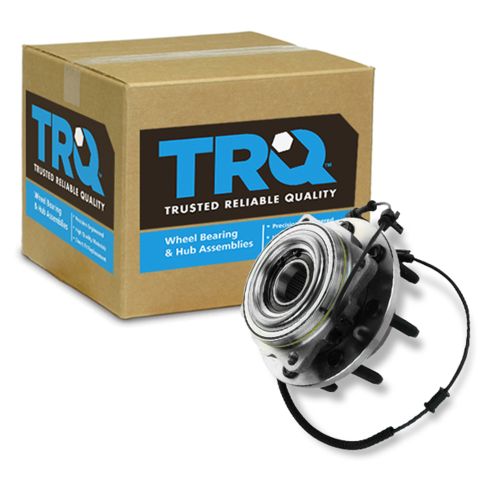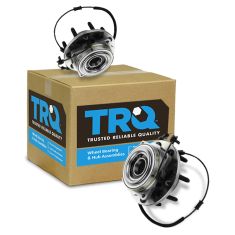1ASHF00438-2011-16 Ford Front Wheel Bearing & Hub Assembly TRQ BHA54097

Replaces
2012 Ford F250 Super Duty Truck 4 Wheel Drive with Single Rear Wheels (SRW) Front Driver Side Wheel Bearing & Hub Assembly TRQ BHA54097

Product Reviews
Loading reviews
4.41/ 5.0
29
29 reviews
Customer service was great
July 9, 2017
Awesome company to work with and great customer service.
August 11, 2017
Had dealer to install. So far very good. Warranty on this part was longer than the oem. Part was delivered very timely.
Ford wheel bearing hub assembly
March 19, 2018
The hub assembly that fits my 2011 Ford F-250 4wheel drive was a great match. I removed the old and match it with the one from 1A Auto and they was a perfect match and it looks to be the same quality as the OEM. Part fit perfectly with no issues. I will definitely recommend 1A Auto Parts for anyone looking for replacement parts.
April 9, 2018
Parts arrived in a timely period parts bolted right on price was also cheapest I found
TRQ Wheel Hubs Ford F 250
May 8, 2018
Overall good quality, so far. But the snap rings that come with them are useless because they broke as soon as I put them on the axle spline to install them. Thankfully,I had the OEM snap rings and they went back in no issues.
September 15, 2018
Shopping online was simple and easy through 1aauto. Parts were affordable and seemed to be made of good material! Install was a breeze, thanks 1aauto!
Low price with top quality!!! 5 star
March 3, 2019
I priced the hub with Ford dealership and local auto part stores. 1aauto was from $150 to $450 cheaper than the other companies. The part was sent fast without any problems. The part fixed my problem without any problems. Thank you for being there to help us save!!!
Wheel Bearings
May 4, 2019
We have ordered quite a few items from this company and have always had good luck with them. Always comes as promised.
High quality
July 6, 2019
High quality and the best price. Delivered promptly.
Excellent quality and value
August 9, 2019
Bought parts to repair my truck before vacation. Parts came quickly and were as promised. Very good quality and everything matched up. Plus the how-to videos helped out tremendously also. Will be buying from here again.
Front hub assembly 2011 F350
September 23, 2019
The replacement hub assembly was an incredible match including the ABS wiring lining up to the attachment points. Successfully replaced both. Reason for 4 stars and not 5 is that I had not known there was a "pair" price. I found the part and ordered two. Had not seen or been aware of the lower price for a pair.
Great
September 30, 2019
Great parts , an quick deliveryWrite
Great product
December 2, 2019
The only reason my purchase doesnt get 5 stars is the snap ring broke before i was even able to install it. As soon as i spread the ring with the pliers it broke. Thankfully the ring that was original to the truck went back on without issue. Other than that issue, the product was great.
Ok for the money.
January 27, 2020
Just put them on. See how many miles before they give up. I'm skeptical on quality cause the one didn't have snap ring in it to hold bearing in.
perfect
February 25, 2020
highly recommend this product, fit like a glove and the video before hand made it simple
Good
May 1, 2020
Great fit seems like OEM quality been on the truck 5 months now no problems
Unit failed after only 1 year and 70k miles
September 18, 2020
Unit fit fine and but failed after only 13 months and 70k miles.
Hub assembly
March 22, 2021
Failed after a year.. supposed to have a lifetime warranty. Wish I could get in contact with someone?
August 17, 2021
perfect fit
February 18, 2022
Purchased a hub assembly for my 2011 Ford F350 super duty and it came out great its fit like a glove I recommend this auto parts store to anybody.
Perfect fit and customers service
June 10, 2022
Perfect fit, great how to videos, and amazing customer service. We had a minor issue with the first shipment, but 1A went over the top to fix the error.
September 15, 2022
New hub is on , now to get the abs & hill decent lights to go off on the dash
Good part
September 15, 2022
Good product so far I have put 10 thousand miles on and have not had any problems will update if it goes out
October 7, 2022
Fit perfect
January 9, 2023
I received hub and had it installed
200 miles later they told me I need to replace that her again how can you help?
February 8, 2023
Very good fit. Quick delivery
Nice new Hub from A1 Auto
[{"url": "https://wac.edgecastcdn.net/001A39/prod/media/pNISJll75W64CYGsite/c93f4e1895c7e70bc7df952cc827e153_1680953768396_0.jpeg", "caption": "Old hub out!"}, {"url": "https://wac.edgecastcdn.net/001A39/prod/media/pNISJll75W64CYGsite/6d7f6ce2f047fffbab9312e96cc1a64c_1680953768396_1.jpeg", "caption": "New hub installed"}, {"url": "https://wac.edgecastcdn.net/001A39/prod/media/pNISJll75W64CYGsite/3a24cffeaed27e297bb566ab9d8bba0e_1680953768396_2.jpeg", "caption": "New Hub & Brakes installed"}]
April 8, 2023
New Hub and speed sensor fit like a glove
Wheel Bearing
August 17, 2023
Good quality bearing and fit perfectly.
October 2, 2024
Good product perfect fit
Customer Q&A
Does this include the O-ring seal and the Hublock gasket?
November 17, 2015
10
It's all in one unit
March 31, 2016
Hayden L
10
Yes it comes complete
February 23, 2017
Keith P
10
Yes its complete
April 9, 2018
K A
10
Yes. Complete set.
March 3, 2019
Chris G
10
Yes
March 3, 2019
Chris G
10
Yes
September 30, 2019
TIM C
Does this include the axle snap ring?
August 7, 2016
10
No
August 8, 2016
Brian F
10
Yes
April 9, 2018
K A
10
Yes
September 30, 2019
TIM C
Does this include the mounting hardware?
July 30, 2019
10
New hardware is not included with this item. You may be able to reuse your original hardware if it is in good condition. Please let us know if you have any other questions.
July 30, 2019
Adam G
Does this come with the mounting studs? or do you re-use the existing?
September 26, 2019
10
The mounting studs are not included so you can purchase locally or reuse the original parts. Please let us know if you have any further questions.
September 26, 2019
Emma F
How much for two
?
September 11, 2021
10
Hello, we would need your vehicle information to assist you further
September 11, 2021
Ricale A
Does this 4 wheel and 6 wheel (dually) trucks?
December 21, 2021
10
This will only be able to fit for vehicles with single rear wheels.
December 21, 2021
Emma F
10
This was for a Mercury Mountianeer, This would not have enough lug studs for a Dual wheel configuration nor will the studs be long enough.
December 21, 2021
L O
Does this hub come with the 4 mounting studs?
October 7, 2022
10
Yes it comes with everything. Fits perfect
October 7, 2022
Gerson C
10
No, it does not. You can reuse your original studs or source them locally.
October 7, 2022
Kelly S
10
Yes
October 21, 2022
B O
Does fit a 2015 ford f250 single rear or double rear wheeled trucks?
April 2, 2023
10
This wheel bearing and hub assembly will fit your 2015 Ford F250, as long as you have a 4WD model. It will fit F250 models with single or dual rear wheels.
April 3, 2023
Meghan R
Would this fit a 2016 f250 as it is basically the same truck or does it switch from 15 to 16?
December 6, 2023
10
Yes it will fit
December 7, 2023
Joshua M
10
There is a vehicle change from the dates 2015-2016 so this would only be able to fit for a 2015 model.
December 7, 2023
Emma F
Ford is a registered trademark of Ford Motor Company. 1A Auto is not affiliated with or sponsored by Ford or Ford Motor Company.
See all trademarks.










